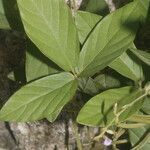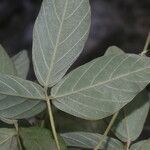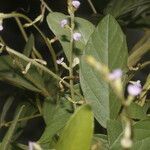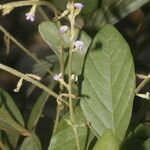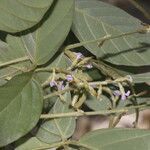Leaves pinnate trifoliolate; leaflets ovate, mostly 4-8 mm long, 1.5-3.5 mm wide, the lateral leaflets slightly smaller, apically obtuse, mucronulate, basally obtuse, discolorous, sparingly sericeous above, densely so beneath; petiolules ca. 2 mm long, tomentose; rachis mostly 3-5 mm long, petiole mostly 2-3 cm long; stipels subulate, about as long as the petiolules; stipules narrow, sericeous, ca. 2 mm long. Inflorescences weak axillary racemes, to 15 cm long; peduncle pilose; brac-teoles 1-2 mm long, subtending the calyx; bracts 1-2 mm long, narrow; pedicels 1-2 mm long, relatively stout, mostly well spaced. Flowers small, inconspicuous, purplish or whitish; calyx sericeous, tubular, the tube ca. 2 mm long, the 5 teeth subulate, subequal, ca. 2 mm long, enclosing most of the corolla; standard ob-ovate. Legume linear, straight or slightly curved, somewhat compressed, 4-7 cm long, partitioned between the seeds sericeous to hispid 2-4 mm wide, the beak 2-3 mm long, abruptly upturned; seeds ca. 3 mm long, reddish brown, plump, rectangular, lustrous.
Inflorescences usually lax pseudoracemes, but occasionally subsessile clusters, covered with golden to dark brown hairs; rhachis 1.5–28 cm long; peduncles 0.5–8 cm long; flowers in 2–4(5)-flowered fascicles along the rhachis; pedicels 1–2(3) mm long; bracteoles 1–2 mm long, lanceolate.
Leaflets 2–11 × 0.5–3.8 cm, elliptic to linear-oblong, discolorous, glabrescent to densely hairy above, sparesly to densely hairy beneath; petiole 1.5–7.5 cm long; rhachis 1–5 mm long; petiolules 1–4 mm long.
Long twining vines, mostly on shrubs and herbs; stems brownish to greyish sericeous with elongate and shorter hairs, the shorter hairs reflexed, glabrescent.
Pods 3–5.5 cm × 2–4 mm, linear, covered with dense spreading or appressed golden to dark brown, sometimes mixed with white, hairs; beak 2–4 mm long.
Seeds light or dark brown or yellow, 2–4 × 1–2 × 1 mm, oblong, smooth, with a small rim aril.
Calyx with white, brown or dark brown hairs; tube 1–2 mm long; lobes 2–3 mm long, equal.
Standard 3–6 × 2–4 mm, obovate, white, green, pink or lilac.
Perennial climber or prostrate herb.
Stems angled.
